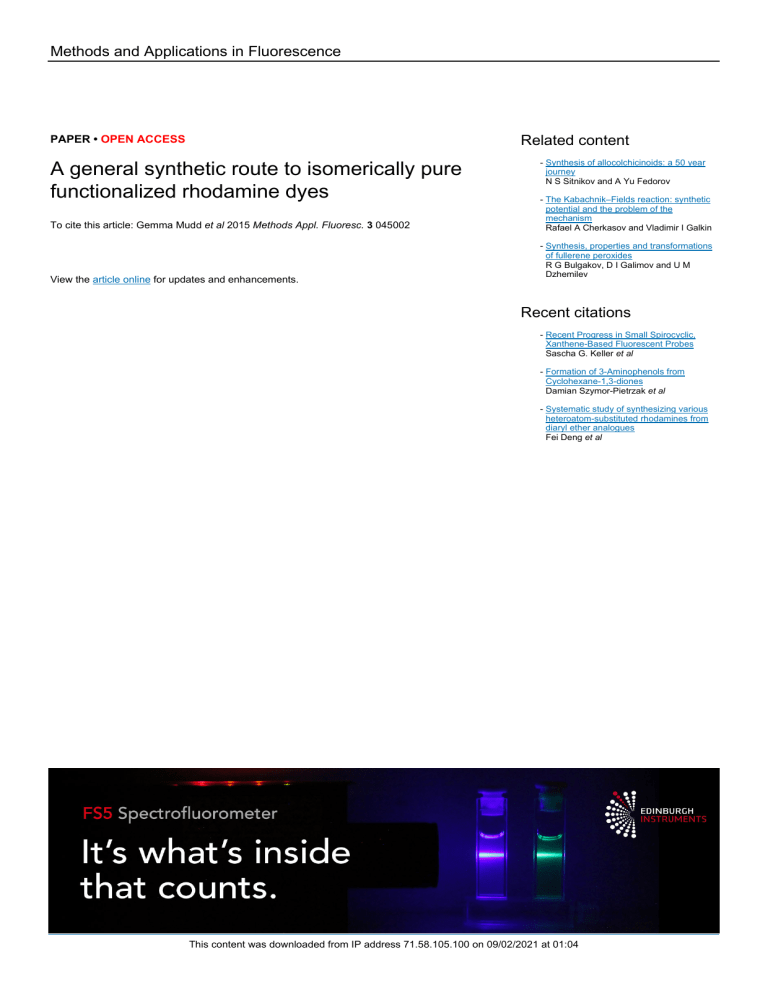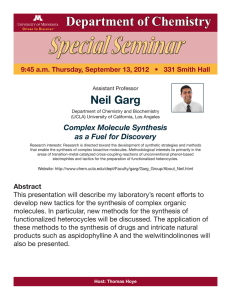
Methods and Applications in Fluorescence Related content PAPER • OPEN ACCESS A general synthetic route to isomerically pure functionalized rhodamine dyes To cite this article: Gemma Mudd et al 2015 Methods Appl. Fluoresc. 3 045002 View the article online for updates and enhancements. - Synthesis of allocolchicinoids: a 50 year journey N S Sitnikov and A Yu Fedorov - The Kabachnik–Fields reaction: synthetic potential and the problem of the mechanism Rafael A Cherkasov and Vladimir I Galkin - Synthesis, properties and transformations of fullerene peroxides R G Bulgakov, D I Galimov and U M Dzhemilev Recent citations - Recent Progress in Small Spirocyclic, Xanthene-Based Fluorescent Probes Sascha G. Keller et al - Formation of 3-Aminophenols from Cyclohexane-1,3-diones Damian Szymor-Pietrzak et al - Systematic study of synthesizing various heteroatom-substituted rhodamines from diaryl ether analogues Fei Deng et al This content was downloaded from IP address 71.58.105.100 on 09/02/2021 at 01:04 Methods Appl. Fluoresc. 3 (2015) 045002 doi:10.1088/2050-6120/3/4/045002 PAPER OPEN ACCESS A general synthetic route to isomerically pure functionalized rhodamine dyes received 14 July 2015 Gemma Mudd, Irene Pérez Pi, Nicholas Fethers, Peter G Dodd, Olivier R Barbeau and Manfred Auer re vised School of Biological Sciences and School of Biomedical Sciences, University of Edinburgh, CH Waddington Building, Max Born Crescent, The King’s Buildings, Edinburgh EH9 3BF, UK 19 August 2015 accep ted for publication 26 August 2015 E-mail: manfred.auer@ed.ac.uk published Keywords: rhodamines, dyes, labelling 14 October 2015 Content from this work may be used under the terms of the Creative Commons Attribution 3.0 licence. Any further distribution of this work must maintain attribution to the author(s) and the title of the work, journal citation and DOI. Supplementary material for this article is available online Abstract A well-documented obstacle in the synthesis of functionalized rhodamine dyes is the generation of regioisomers which are difficult to separate. These isomers occur due to the use of unsymmetrical anhydride reagents, which possess two potential points of reactivity where condensation with metaaminophenols can take place. In this report we describe a method which eliminates this problem by using phthalaldehydic acids as anhydride replacements. These reagents provide only one point of reactivity for the aminophenol, thus allowing direct access to single isomer tetramethylrhodamines and avoiding isomer generation altogether. A range of functionalities are shown to be tolerated at the 5- and 6-position of the dye compounds which are prepared in up to gram quantities using our method. The scope of the method is further demonstrated by the preparation of additional rhodamine family members Rhodamine B and X-Rhodamine. Rhodamines are a family of fluorescent dyes based on a xathene core scaffold (figure 1). They have broad reaching applications in imaging and bioanalysis due to their photostability, high absorption coefficients and excellent fluorescence quantum yields [1]. Tetramethylrhodamine (TMR) has been used extensively in protein, oligonucleotide labelling, and DNA sequencing, amongst other areas [2–4]. Despite the widespread utility of TMR and related functionalized rhodamines in biochemical processes, the preparation and isolation of these dyes remains a significant synthetic challenge. As yet, a general isomerselective synthesis has not been described. The standard synthetic route currently employed produces two isomers that are known to display different properties. These include differing electrophoretic mobility, reactivity and even cell toxicity in some cases [5–7]. TMR and other commercially available rhodamines are generally prepared via two sequential Friedel Crafts type reactions of a phthalic anhydride with two equivalents of a meta-aminophenol, which forms the xanthene core [8–10]. However, when applied to the synthesis of functionalized rhodamines—which contain a functional handle required for labelling of chemical and biological entities—this route leads to a mixture of isomeric rhodamines (scheme 1). © 2015 IOP Publishing Ltd The functional handle is introduced at the beginning of the synthesis via use of a functionalized a­ nhydride starting material (for carboxytetramethylrhodamine, carboxyphthalic anhydride, 3 is used). However, as both carbonyls of the anhydride can participate in the Friedel Crafts reaction, this generates regioisomeric intermediates 5, and eventually two isomers of the desired rhodamine dye 6, which are difficult to separate. Numerous methods for isomer separation have been reported [11–14], including fractional crystallisation and column chromatography, both of which present individual difficulties. As a result, a general and simple method by which commonly used single isomer functionalized rhodamines can be produced remains a significant but important challenge to synthetic chemists. Recently, Lavis et al reported an elegant synthetic strategy where a variety of single isomer rhodamines bearing a 5-carboxylic acid linker were synthesized via conversion of isomerically pure fluoresceins into rhodamines using palladium mediated C-N cross coupling (scheme 2) [15]. Whilst useful, this method does not allow the generation of X-rhodamine and Q-rhodamine, where the xanthene anilines are substituted with fused cyclic rings. The use of palladium cross-coupling could also Methods Appl. Fluoresc. 3 (2015) 045002 G Mudd et al Figure 1. Structures of Rhodamine 1 and tetramethylrhodamine (TMR) 2. Xanthene core highlighted in blue. Scheme 1. Reported synthesis of carboxytetramethylrhodamine (TAMRA). preclude the incorporation of a halogen functionality onto the pendent aromatic ring. The elevated temperatures employed in this reaction also render the use of volatile amines such as dimethylamine (used to generate tetramethylrhodamine) impractical on a large scale. Herein, we report a simple and robust synthetic route to commonly used single isomer functionalized rhodamines bearing a range of groups on the pendent ring, allowing for conjugation to other entities by a range of chemical methods. Our investigation began by assessing alternative starting materials, key to preventing isomer generation during rhodamine synthesis. Replacement of the commonly used anhydride with a compound which bears a single point for aminophenols to react was targeted. In the same manner that aminophenols can be condensed with benzaldehydes to give rosamines (scheme 3(a)) [16, 17], and sulfoxanthene dyes can be obtained from formylbenzene-1,3-disulfonic acid [18], it was envisaged that functionalized phthalaldehydic acids (or 2-formyl benzoic acids) could be potential replacements for anhydrides in the synthesis of rhodamine dyes (scheme 3(b)). The use of phthalaldehydic acids ensures the generation of only one isomer, while 2 k­ eeping the ortho-carboxylic acid present in rhodamines which is absent in rosamines. Phthalaldehydic acids can be generated from phthalides which are commercially available with a range of pre-installed functional groups in the 5- and 6-position. This conversion is well documented in the literature [19, 20] and involves two simple chemical manipulations which allow access to the desired acids; bromination of the 3-position of the phthalide, followed by subjection of the brominated species to hot water, which gives the desired aldehyde and ortho-­ carboxylic acid functionality. Phthalides bearing a variety of useful functional groups in the 5- and 6-position were transformed into the corresponding phthalaldehydic acids (table 1). The process was amenable to all substituents tested, with bromination of the phthalides proceeding in 61–97% yield. This was achieved by heating in the presence of N-bromosuccinimide (NBS) and a radical initiator 1,1′-azobis(cyclohexanecarbonitrile) (ACHN) under UV irradiation. Subsequent opening of the lactone ring by heating at 90 °C in H2O proceeded smoothly within a few hours in near quantitative yield (85–98%) for all reactions. Methods Appl. Fluoresc. 3 (2015) 045002 G Mudd et al Scheme 2. Lavis route to 5-carboxy functionalized rhodamines. Table 1. Preparation of phthalaldehydic acids. Entry R1 R2 1 CN H 70a 98 2 CO2Me H 85 97 3 Br H 97 90 4 H NO2 61 85 Table 2. Production of functionalized tetramethylrhodamines. Yield i (%) Yield ii (%) Entry R1 Note. No ACHN or UV irradiation was used in the bromination of this substrate. 1 CN H 50 2 CO2Me H 51 Next, the phthalaldehydic acids 17 were reacted with 3 equivalents of 3-dimethylaminophenol 4 to generate the corresponding tetramethylrhodamines 19 (table 2). Solubility of the reagents proved to be an issue in solvents such as methanesulfonic acid, 60% hydrochloric acid and 60% sulfuric acid, however propionic acid proved suitable and was therefore utilized for this reaction. The reagents were heated in propionic acid with catalytic p-toluene sulfonic acid to form diphenol intermediate 18. The intermediate was oxidized in situ using chloranil to yield the desired functionalized TMRs as single isomers, which could be easily isolated using silica gel chromatography. The consistent yields observed for table 2, entries 1–3 (50–54%) suggest that changes in linkage groups at the 6-position on the pendent ring are well tolerated in this reaction. The scope of the reaction also extends to include substituents at the 5-position of TMR, 3 Br H 54 4 H NO2 58 3 R2 Yield over 2 steps (%) ­ emonstrated by the isolation of 5-NO2-TMR in 58% d yield (entry 4, table 2)). Carboxylic acid functionalized tetramethylrhodamine (TAMRA) is commonly used for tethering biological or chemical entities via amide bond formation, and so the production of isomerically pure derivatives of this was pursued next. Both 6-CN-TMR and 6-CO2MeTMR were assessed to ascertain the best method for generation of 6-CO2H-TMR (or 6-TAMRA). Hydrolysis of the nitrile group of 6-CN-TMR by refluxing in 85% H2SO4 proved to be slow (incomplete after 36 h) and side products began to form, causing concern for the integrity of the dye under harsh conditions. Conversely, hydrolysis of the methyl ester group of 6-CO2Me-TMR 20 proceeded to completion cleanly Methods Appl. Fluoresc. 3 (2015) 045002 G Mudd et al Scheme 3. (a) Synthesis of rosamines and (b) proposed single isomer synthesis of rhodamines using phthalaldehydic acids. Scheme 4. Isolation of 6-TAMRA. within one hour at room temperature using sodium hydroxide (scheme 4). Acidification of the reaction mixture caused 6-TAMRA 21 to precipitate out of the aqueous solution, allowing it to be filtered and isolated in excellent yield (89%). The synthesis of 6-TAMRA 21 was proven to be amenable to gram scale amounts, with yields comparable to that of the smaller scale on which development reactions were typically carried out (see SI for further details). The scope of the process was further investigated by assessing other aminophenols in order to access additional rhodamine family members (scheme 5). 3-Diethylaminophenol 23 was employed under the conditions shown above with phthalaldehydic acid 22. This method successfully produced rhodamine-B 24 in 70 % yield. 8-Hydroxyjulolidine 25 was also evaluated in the system, giving X-rhodamine analogue 26 in 47% yield. Azide functionalized TAMRA is a highly useful reagent for labeling alkyne-containing biological molecules in an orthogonal fashion through the wellknown copper-catalyzed azide—alkyne cycloaddition (CuAAC), click chemistry [21–26]. This fluorescent probe can be prepared through functionalization of 4 6-TAMRA 21 with 3-azidopropylamine 27 [27], via amide coupling to give 6-N3-TMR 28. To ensure optimal conversion of 6-TAMRA 21 to azide bearing rhodamine 28, a systematic survey of coupling reagents was undertaken (table 3). Reactions were carried out in the presence of 2 equivalents of DIPEA and 5 equivalents of 3-azidopropylamine 27. Reactions were monitored at 1, 2, 4, 8 and 24 h intervals via HPLC. HATU was determined to give the highest conversion (entry 1). When carrying out the amide coupling with HATU, 6-N3-TMR 28 was isolated in 40% yield when purified by semi-preparative HPLC. In conclusion, a robust and scalable synthesis for the generation of highly valuable single isomer functionalized rhodamines has been developed. This approach allows great flexibility in rhodamine synthesis and shows broad scope, enabling access to a range of functionalized rhodamines from phthalides without the need for arduous isomer separation. It is expected that this work will allow easy generation of novel single isomer rhodamine compounds, useful in exciting new areas of fluorescence technology, e.g. the generation of improved dyes for super resolution microscopy [28, 29]. Methods Appl. Fluoresc. 3 (2015) 045002 G Mudd et al Scheme 5. Generation of rhodamine B and X-rhodamine. Table 3. Evaluation of Amide Coupling Reagents via the Internet at stacks.iop.org/MAF/3/045002/ mmedia. Notes The authors declare no competing interests exist. Dedication This article is submitted in memory of Dr Angus Brown. Entry Coupling reagent Time (hours) Conversion (%)a References 1 HATU 2 81 2 DIC 24 42 3 PyBop 24 0 4 EDC 24 50 5 TSTU 2 28 [1] Beija M, Afonso C A M and Martinho J M G 2009 Synthesis and applications of Rhodamine derivatives as fluorescent probes Chem. Soc. Rev. 38 2410–33 [2] Chan L N et al 2009 A novel approach to tag and identify geranylgeranylated proteins Electrophoresis 30 3598–606 [3] Mullah B and Andrus A 1997 Automated synthesis of double dye-labeled oligonucleotides using tetramethylrhodamine (TAMRA) solid supports Tetrahedron Lett. 38 5751–4 [4] Ansorge W, Sproat B S, Stegemann J and Schwager C 1986 A non-radioactive automated method for DNA sequence determination J. Biochem. Biophys. Methods 13 315–23 [5] Menchen S M and Fung S 1991 5- and 6-succinimidylcarboxylate isomers of rhodamine dyes European Patent EPO 0272007 A2 [6] Kolmakov K et al 2014 Polar red-emitting rhodamine dyes with reactive groups: synthesis, photophysical properties, and two-color STED nanoscopy applications Chem. Eur. J. 20 146–57 [7] Stagge F, Mitronova G Y, Belov V N, Wurm C A and Jakobs S 2013 Snap-, CLIP- and Halo-tag labelling of budding yeast cells PLoS One 8 e78745 [8] Uddin M J and Marnett L J 2008 Synthesis of 5- and 6-carboxy-X-rhodamines Org. Lett. 10 4799–801 [9] Lee M and Grissom C B 2009 Design, synthesis, and characterization of fluorescent cobalamin analogues with high quantum efficiencies Org. Lett. 11 2499–502 [10] Kojima H et al 2001 Bioimaging of nitric oxide with fluorescent indicators based on the rhodamine chromophore Anal. Chem. 73 1967–73 a Conversion determined by analytical RP-HPLC. Acknowledgments The authors also acknowledge financial support from the Scottish Universities Life Sciences Alliance (SULSA) (BioSKAPE/BBSRC CASE Studentship to GM), Medical Research Council (MRC), and by the European Community’s 7th Framework Program (FP7/2007– 2013) under grant agreement no 278568 ‘PRIMES’. The funders had no role in study design, data collection and analysis, decision to publish, or preparation of the manuscript. Associated content Supporting information Synthetic procedures and characterization of compounds. This material is available free of charge 5 Methods Appl. Fluoresc. 3 (2015) 045002 G Mudd et al [11] Corrie J 1994 Synthesis and characterisation of pure isomers of iodoacetamidotetramethylrhodamine J. Chem. Soc. Perkin Trans. 1 2967–73 [12] Kvach M V et al 2009 Practical synthesis of isomerically pure 5- and 6-carboxytetramethylrhodamines, useful dyes for DNA probes Bioconjugate Chem. 20 1673–82 [13] Brunet A, Aslam T and Bradley M 2014 Separating the isomers—efficient synthesis of the N-hydroxysuccinimide esters of 5 and 6-carboxyfluorescein diacetate and 5 and 6-carboxyrhodamine B Bioorg. Med. Chem. Lett. 24 3186–8 [14] Yu H, Xiao Y and Guo H 2012 From spirolactam mixtures to regioisomerically pure 5- and 6-rhodamines: a chemodosimeter-inspired strategy Org. Lett. 14 2014–7 [15] Grimm J B and Lavis L D 2011 Synthesis of rhodamines from fluoresceins using Pd-catalyzed C-N cross-coupling Org. Lett. 13 6354–7 [16] Jiao G-S, Castro J C, Thoresen L H and Burgess K 2003 Microwave-assisted syntheses of regioisomerically pure bromorhodamine derivatives Org. Lett. 5 3675–7 [17] Cardoso I C S et al 2012 Microwave-assisted synthesis and spectroscopic properties of 4′-substituted rosamine fluorophores and naphthyl analogues Eur. J. Org. Chem. 2012 5810–7 [18] Chevalier A, Renard P-Y and Romieu A 2014 Straightforward access to water-soluble unsymmetrical sulfoxanthene dyes: application to the preparation of far-red fluorescent dyes with large stokes’ shifts Chem. Eur. J. 20 8330–7 [19] Wang B, Chai X, Zhu W, Wang T and Wu Q 2014 A general approach to spirolactonized Si-rhodamines Chem. Commun. 50 14374–7 [20] Mirabdolbaghi R and Dudding T 2012 An indium-mediated allylative/transesterification DFT-directed approach to chiral C(3)-functionalized phthalides Org. Lett. 14 3748–51 6 [21] Tornøe C W, Christensen C and Meldal M 2002 Peptidotriazoles on solid phase: [1,2,3]-triazoles by regiospecific copper(I)-catalyzed 1,3-dipolar cycloadditions of terminal alkynes to azides J. Org. Chem. 67 3057–64 [22] Rostovtsev V V, Green L G, Fokin V V and Sharpless K B 2002 A stepwise Huisgen cycloaddition process: copper(I)-catalyzed regioselective ‘ligation’ of azides and terminal alkynes Angew. Chem. Int. Edn 41 2596–9 [23] Kolb H C, Finn M G and Sharpless K B 2001 Click chemistry: diverse chemical function from a few good reactions Angew. Chem. Int. Edn 40 2004–21 [24] Sletten E M and B C R Bioorthogonal 2009 Chemistry: fishing for selectivity in a sea of functionality Angew. Chem. Int. Edn 48 6974–98 [25] Wang Q et al 2003 Bioconjugation by copper(I)-catalyzed azide-alkyne [3 + 2] cycloaddition J. Am. Chem. Soc. 125 3192–3 [26] Agard N J, Prescher J A and Bertozzi C R 2004 A strainpromoted [3 + 2] azide-alkyne cycloaddition for covalent modification of biomolecules in living systems J. Am. Chem. Soc. 126 15046–7 [27] Carboni B, Benalil A and Vaultier M 1993 Aliphatic amino azides as key building blocks for efficient polyamine syntheses J. Org. Chem. 58 3736–41 [28] Belov V N et al 2014 Masked rhodamine dyes of five principal colors revealed by photolysis of a 2-diazo-1-indanone caging group: synthesis, photophysics, and light microscopy applications Chem. Eur. J. 20 13162–73 [29] Mitronova G Y et al 2015 Functionalization of the meso -phenyl ring of rhodamine dyes through SN Ar with sulfur nucleophiles: synthesis, biophysical characterizations, and comprehensive NMR analysis Eur. J. Org. Chem. 2015 337–49


